|
Henry Ford |
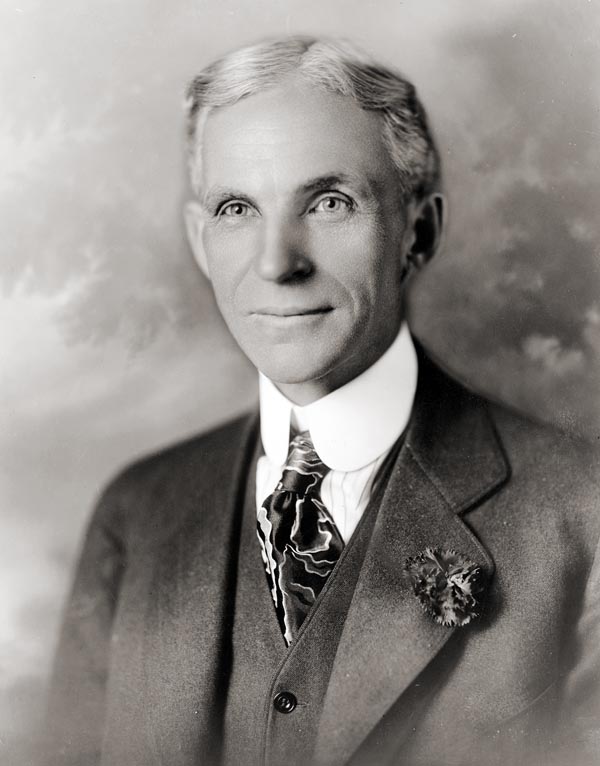
Henry Ford,
c. 1919 |
|
Born |
July 30, 1863
(1863-07-30)
Greenfield Township, Michigan, U.S. |
|
Died |
April 7, 1947
(1947-04-07)
(aged 83)
Fair Lane, Dearborn, Michigan, U.S. |
|
Occupation |
Business,
Engineering |
|
Net worth |
$188.1 billion, based on
information from Forbes, February 2008. |
|
Religion |
Protestant Episcopal |
|
Spouse |
Clara Jane Bryant |
|
Children |
Edsel Ford |
|
Parents |
William Ford and Mary Ford |
|
Signature |
 |
Related Article:
Henry Ford -
This is Your Life
He was known worldwide especially in the 1920s
as a promoter of pacifism and as a publisher of
antisemitic texts such as the book The
International Jew.
Early years
Ford was born July 30, 1863, on a farm in Greenfield Township (near Detroit,
Michigan). His father, William Ford (1826?1905), was born in County Cork,
Ireland, of a family originally from western England, who were among
migrants to Ireland as the English created plantations. His mother, Mary
Litogot Ford (1839?1876), was born in Michigan; she was the youngest child
of Belgian immigrants; her parents died when Mary was a child and she was
adopted by neighbors, the O'Herns. Henry Ford's siblings include Margaret
Ford (1867?1938); Jane Ford (c. 1868?1945); William Ford (1871?1917) and
Robert Ford (1873?1934).
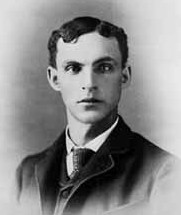 His father gave him a pocket watch in his early teens. At 15, Ford
dismantled and reassembled the timepieces of friends and neighbors dozens of
times, gaining the reputation of a watch repairman. At twenty, Ford walked
four miles to their Episcopal church every Sunday. His father gave him a pocket watch in his early teens. At 15, Ford
dismantled and reassembled the timepieces of friends and neighbors dozens of
times, gaining the reputation of a watch repairman. At twenty, Ford walked
four miles to their Episcopal church every Sunday.
Ford was devastated when his mother died in 1876. His father expected him to
eventually take over the family farm, but he despised farm work. He later
wrote, "I never had any particular love for the farm?it was the mother on
the farm I loved."
In 1879, he left home to work as an apprentice machinist in the city of
Detroit, first with James F. Flower & Bros., and later with the Detroit Dry
Dock Co. In 1882, he returned to Dearborn to work on the family farm, where
he became adept at operating the Westinghouse portable steam engine. He was
later hired by Westinghouse company to service their steam engines. During
this period Ford also studied bookkeeping at Goldsmith, Bryant & Stratton
Business College in Detroit.
Marriage and Family
Ford married Clara Ala Bryant (1866?1950) in 1888 and supported himself by
farming and running a sawmill. They had a single child: Edsel Ford
(1893?1943).
Career
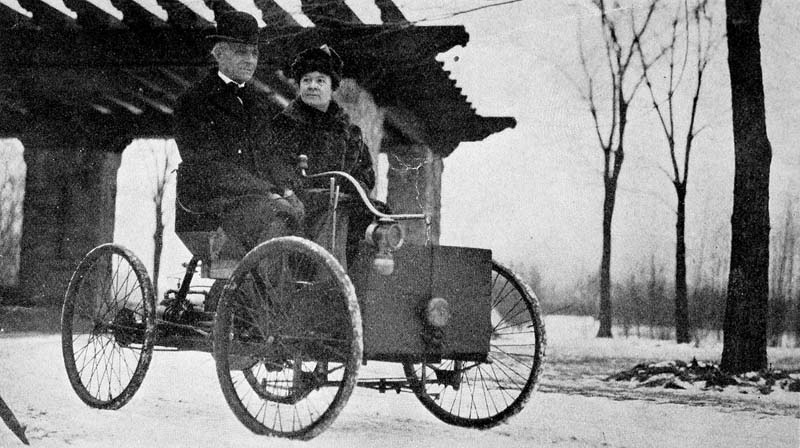 In
1891, Ford became an engineer with the Edison Illuminating
Company. After his promotion to Chief Engineer in 1893, he had
enough time and money to devote attention to his personal
experiments on gasoline engines. These experiments culminated in
1896 with the completion of a self-propelled vehicle which he
named the Ford Quadricycle. He test-drove it on June 4. After
various test-drives, Ford brainstormed ways to improve the
Quadricycle. In
1891, Ford became an engineer with the Edison Illuminating
Company. After his promotion to Chief Engineer in 1893, he had
enough time and money to devote attention to his personal
experiments on gasoline engines. These experiments culminated in
1896 with the completion of a self-propelled vehicle which he
named the Ford Quadricycle. He test-drove it on June 4. After
various test-drives, Ford brainstormed ways to improve the
Quadricycle.
Also in 1896, Ford attended a meeting of Edison executives,
where he was introduced to Thomas Edison. Edison approved of
Ford's automobile experimentation; encouraged by him, Ford
designed and built a second vehicle, completing it in 1898.
Backed by the capital of Detroit lumber baron William H. Murphy,
Ford resigned from Edison and founded the Detroit Automobile
Company on August 5, 1899. However, the automobiles produced
were of a lower quality and higher price than Ford liked.
Ultimately, the company was not successful and was dissolved in
January 1901.
With the help of C. Harold Wills, Ford designed, built, and
successfully raced a 26-horsepower automobile in October 1901.
With this success, Murphy and other stockholders in the Detroit
Automobile Company formed the Henry Ford Company on November 30,
1901, with Ford as chief engineer. However, Murphy brought in
Henry M. Leland as a consultant and, as a result, Ford left the
company bearing his name in 1902. With Ford gone, Murphy renamed
the company the Cadillac Automobile Company.
Teaming up with former racing cyclist Tom Cooper, Ford also
produced the 80+ horsepower racer "999" which Barney Oldfield
was to drive to victory in a race in October 1902. Ford received
the backing of an old acquaintance, Alexander Y. Malcomson, a
Detroit-area coal dealer. They formed a partnership, "Ford & Malcomson, Ltd." to manufacture automobiles. Ford went to work
designing an inexpensive automobile, and the duo leased a
factory and contracted with a machine shop owned by John and
Horace E. Dodge to supply over $160,000 in parts. Sales were
slow, and a crisis arose when the Dodge brothers demanded
payment for their first shipment.
A
Tinkerer In An Emerging Industry
By rights, Henry Ford
probably should have been a farmer. He was born in 1863 in
Dearborn, Michigan, on the farm operated by his father, an
Irishman, and his mother, who was from Dutch stock. Even as a
boy, young Henry had an aptitude for inventing and used it to
make machines that reduced the drudgery of farm chores. At the
age of thirteen, he saw a coal-fired steam engine lumbering
along a long rural road, a sight that galvanized his fascination
with machines. At sixteen, against the wishes of his father, he
left the farm for Detroit, where he found work as a mechanic's
apprentice. Over the next dozen years he advanced steadily, and
became chief engineer at the Edison Illuminating Company.
At twenty-four, Ford
married Clara Bryant, a friend of his sister's; he called her
"The Believer," because she encouraged his plans to build a
horseless carriage from their earliest days together. For as
Henry Ford oversaw the steam engines and turbines that produced
electricity for Detroit Edison, inventors in the U.S. and Europe
were adapting such engines to small passenger vehicles. On
January 29, 1886, Karl Benz received a patent for a crude
gas-fueled car, which he demonstrated later that year on the
streets of Mannhelm, Germany. And in 1893, Charles and Frank
Duryea, of Springfield, Massachusetts, built the first
gas-operated vehicle in the U.S.
In the 1890s, any mechanic with tools, a workbench, and a
healthy imagination was a potential titan in the infant
industry. Even while continuing his career at Edison, Ford
devoted himself to making a working automobile. In 1891, he
presented Clara with a design for an internal combustion engine,
drawn on the back of a piece of sheet music. Bringing the design
to reality was another matter, but on Christmas Eve 1893 he made
a successful test of one of his engines, in the kitchen sink.
The engine was merely the heart of the new machine that Ford
hoped to build. On weekends and most nights, he could be found
in a shed in the back of the family home, building the rest of
the car. So great was his obsession that the neighbors called
him Crazy Henry. However, at 2:00 A.M. on June 4, 1896, Crazy
Henry punched a large hole in the wall of his shed, and emerged
at the wheel of an automobile -- his automobile. In the weeks
that followed, Ford was often seen driving around the streets of
Detroit.
Later that year, Ford attended a national meeting of Edison
employees. Thomas A. Edison had been Ford's idol for years. But
at the meeting, it was Edison who asked to meet the young
inventor, after word got around that the obscure engineer from
Detroit had actually built an automobile. "Young man, you have
the right idea," Edison said. "Keep right at it". Ironically, he
was adamant that Ford not waste his time trying to make a car
run viably on electricity.
Back in Detroit, Ford showed that he was no mere hobbyist: he
sold his prototype for $200. For three years, he watched the new
field of automaking develop, and he progressed along with it. In
1899, thirty American manufacturers -- most of them based in New
England -- produced about 2,500 cars. Still, most Americans in
the market for automobiles became accustomed to buying imported
ones. In 1898, though, the domestic bicycle industry faced an
unusual slump and many manufacturers decided to turn to
automaking to keep the factories busy.
Offered a senior position and part ownership of a new company,
the Detroit Automobile Co., Ford, thirty-six years old, quit the
Edison Illuminating Company. Across town, the firm that would
become Oldsmobile was launched at the same time. The Detroit
Automobile Co. failed, without producing any cars, and Henry
Ford was ousted by angry investors. (The firm survived, emerging
from reorganization as the Cadillac Motor Car Company.)
Building a Car for the Great
Multitude
Ford continued to
pursue his dream. Early automobile promotion took place largely
on the racetrack, where manufacturers sought to prove
roadworthiness by putting their cars on public view and pressing
them to their very limits. In 1901, Henry Ford poured his
expertise into a pair of big race cars, one of which he entered
in a ten-mile match race against a car built by Alexander
Winton, a leading automaker from Ohio. The race took place in
Grosse Pointe, Michigan, and Ford's car won. Because of the
victory, the coal merchant Alexander Malcomson agreed to back
Ford in a new business venture. In 1903, they formed the Ford
Motor Company, in association with about a dozen other
investors. Capitalized at $100,000, the company actually started
with cash on hand of about $28,000. Some investors contributed
other types of capital; for example, the Dodge brothers, John
and Horace, agreed to supply engines.
The company purchased most of the major components for its new
models, a common practice of the day. Teams of mechanics built
cars individually at workstations, gathering parts as needed
until a car was complete. In 1903, Ford's 125 workers made 1,700
cars in three different models. The cars were comparatively
expensive, and their high profit-margins pleased the
stockholders. Malcomson decided to start yet another automobile
company. But when it failed, he was forced to sell his other
assets, including his shares in Ford. Henry Ford bought enough
of them to assume a majority position. The most important
stockholder outside of the Ford family was James Couzens,
Malcomson's former clerk; as General Manager, then vice
president and secretary-treasurer at the Ford Motor Company, he
was effectively second-in-command throughout many of the Model T
years.
The direction of the company toward even pricier models had
bothered Henry Ford. He used his new power to curtail their
production, a move that coincided with the Panic of 1907. This
case of accidental good timing probably saved the company. Ford,
insisting that high prices ultimately slowed market expansion,
had decided in 1906 to introduce a new, cheaper model with a
lower profit margin: the Model N. Many of his backers disagreed.
While the N was only a tepid success, Ford nonetheless pressed
forward with the design of the car he really wanted to build.
The car that would be the Model T.
 "I
will build a motorcar for the great multitude," he
proclaimed. Such a notion was revolutionary. Until then the
automobile had been a status symbol painstakingly manufactured
by craftsmen. But Ford set out to make the car a commodity.
"Just like one pin is like another pin when it comes from the
pin factory, or one match is like another match when it comes
from the match factory," he said. This was but the first of
several counterintuitive moves that Ford made throughout his
unpredictable career. Prickly, brilliant, willfully eccentric,
he relied more on instinct than business plans. As the eminent
economist John Kenneth Galbraith later said: "If there is any
certainty as to what a businessman is, he is assuredly the
things Ford was not." "I
will build a motorcar for the great multitude," he
proclaimed. Such a notion was revolutionary. Until then the
automobile had been a status symbol painstakingly manufactured
by craftsmen. But Ford set out to make the car a commodity.
"Just like one pin is like another pin when it comes from the
pin factory, or one match is like another match when it comes
from the match factory," he said. This was but the first of
several counterintuitive moves that Ford made throughout his
unpredictable career. Prickly, brilliant, willfully eccentric,
he relied more on instinct than business plans. As the eminent
economist John Kenneth Galbraith later said: "If there is any
certainty as to what a businessman is, he is assuredly the
things Ford was not."
In the winter of 1906, Ford had secretly partitioned a twelve-by
fifteen-foot room in his plant, on Piquette Avenue in Detroit.
With a few colleagues, he devoted two years to the design and
planning of the Model T. Early on, they made an extensive study
of materials, the most valuable aspect of which began in an
offhand way. During a car race in Florida, Ford examined the
wreckage of a French car and noticed that many of its parts were
of lighter-than-ordinary steel. The team on Piquette Avenue
ascertained that the French steel was a vanadium alloy, but that
no one in America knew how to make it. The finest steel alloys
then used in American automaking provided 60,000 pounds of
tensile strength. Ford learned that vanadium steel, which was
much lighter, provided 170,000 pounds of tensile strength. As
part of the pre-production for the new model, Ford imported a
metallurgist and bankrolled a steel mill. As a result, the only
cars in the world to utilize vanadium steel in the next five
years would be French luxury cars and the Ford Model T. A Model
T might break down every so often, but it would not break.
The car that finally emerged from Ford's secret design section
at the factory would change America forever. For $825, a Model T
customer could take home a car that was light, at about 1,200
pounds; relatively powerful, with a four-cylinder, twenty
horsepower engine, and fairly easy to drive, with a two-speed,
foot-controlled "planetary" transmission. Simple, sturdy, and
versatile, the little car would excite the public imagination.
It certainly fired up its inventor: when Henry Ford brought the
prototype out of the factory for its first test drive, he was
too excited to drive. An assistant had to take the wheel.
"Well, I guess we've got started," Ford observed at the time.
The car went to the first customers on October 1, 1908. In its
first year, over ten thousand were sold, a new record for an
automobile model. Sales of the "Tin Lizzie," or "flivver," as
the T was known, were boosted by promotional activities ranging
from a black-tie "Ford Clinic" in New York, where a team of
mechanics showcased the car, to Model T rodeos out west, in
which cowboys riding in Fords tried to rope calves. In 1909,
mining magnate Robert Guggenheim sponsored an auto race from New
York to Seattle in which the only survivors were two Model T
Fords. "I believe Mr. Ford has the solution of the popular
automobile," Guggenheim concluded.
In the early years, Model Ts were produced at Piquette Avenue in
much the same way that all other cars were built. Growing demand
for the new Ford overwhelmed the old method, though. Ford
realized that he not only had to build a new factory, but a new
system within that factory.
Throughout his tenure as the head of the company, Henry Ford
believed in maintaining enormous cash reserves, a policy that
allowed him to plan a new facility for production of the Model T
without interference or outside pressure. The new Highland Park
factory, which opened in 1910, was designed by the nation's
leading industrial architect, Albert Kahn. It was unparalleled
in scale, sprawling over sixty-two acres. John D. Rockefeller,
whose Standard Oil refineries had always represented
state-of-the-art design, called Highland Park "the industrial
miracle of the age."
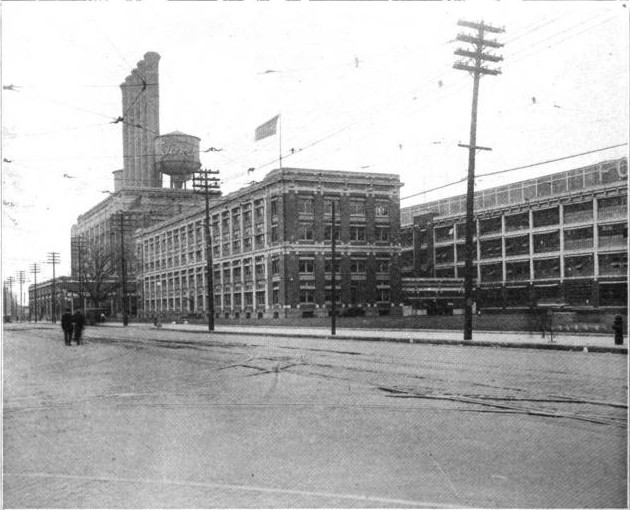 In
its first few years, the four-story Highland Park factory was
organized from top to bottom. Assembly wound downward, from the
fourth floor, where body panels were hammered out, to the third
floor, where workers placed tires on wheels and painted auto
bodies. After assembly was completed on the second floor, new
automobiles descended a final ramp past the first-floor offices.
Production increased by approximately 100 percent in each of the
first three years, from 19,000 in 1910, to 34,500 in 1911, to a
staggering 78,440 in 1912. It was still only a start. In
its first few years, the four-story Highland Park factory was
organized from top to bottom. Assembly wound downward, from the
fourth floor, where body panels were hammered out, to the third
floor, where workers placed tires on wheels and painted auto
bodies. After assembly was completed on the second floor, new
automobiles descended a final ramp past the first-floor offices.
Production increased by approximately 100 percent in each of the
first three years, from 19,000 in 1910, to 34,500 in 1911, to a
staggering 78,440 in 1912. It was still only a start.
"I'm going to democratize the automobile," Henry Ford had said
in 1909. "When I'm through, everybody will be able to afford
one, and about everybody will have one." The means to this end
was a continuous reduction in price. When it sold for $575 in
1912, the Model T for the first time cost less than the
prevailing average annual wage in the United States. Ignoring
conventional wisdom, Ford continually sacrificed profit margins
to increase sales. In fact, profits per car did fall as he
slashed prices from $220 in 1909 to $99 in 1914. But sales
exploded, rising to 248,000 in 1913. Moreover, Ford demonstrated
that a strategic, systematic lowering of prices could boost
profits, as net income rose from $3 million in 1909 to $25
million in 1914. As Ford's U.S. market share rose from a
respectable 9.4 percent in 1908 to a formidable 48 percent in
1914, the Model T dominated the world's leading market.
At Highland Park, Ford began to implement factory automation in
1910. But experimentation would continue every single day for
the next seventeen years, under one of Ford's maxims:
"Everything can always be done better than it is being done."
Ford and his efficiency experts examined every aspect of
assembly and tested new methods to increase productivity. The
boss himself claimed to have found the inspiration for the
greatest breakthrough of all, the moving assembly line, on a
trip to Chicago: "The idea came in a general way from the
overhead trolley that the Chicago packers use in dressing beef,"
Ford said. At the stockyards, butchers removed certain cuts as
each carcass passed by, until nothing was left. Ford reversed
the process. His use of the moving assembly line was complicated
by the fact that parts, often made on sub-assembly lines, had to
feed smoothly into the process. Timing was crucial: a clog along
a smaller line would slow work farther along. The first moving
line was tested with assembly of the flywheel magneto, showing a
saving of six minutes, fifty seconds over the old method. As
similar lines were implemented throughout Highland Park, the
assembly time for a Model T chassis dropped from twelve hours,
thirty minutes to five hours, fifty minutes.
 The
pace only accelerated, as Ford's production engineers
experimented with work slides, rollways, conveyor belts, and
hundreds of other ideas. The first and most effective assembly
line in the automobile industry was continually upgraded. Those
most affected were, of course, the workers. As early as January
1914, Ford developed an "endless chain-driven" conveyor to move
the chassis from one workstation to another; workers remained
stationary. Three months later, the company created a "man high"
line -- with all the parts and belts at waist level, so that
workers could repeat their assigned tasks without having to move
their feet. The
pace only accelerated, as Ford's production engineers
experimented with work slides, rollways, conveyor belts, and
hundreds of other ideas. The first and most effective assembly
line in the automobile industry was continually upgraded. Those
most affected were, of course, the workers. As early as January
1914, Ford developed an "endless chain-driven" conveyor to move
the chassis from one workstation to another; workers remained
stationary. Three months later, the company created a "man high"
line -- with all the parts and belts at waist level, so that
workers could repeat their assigned tasks without having to move
their feet.
In 1914, 13,000 workers at Ford made 260,720 cars. By
comparison, in the rest of the industry, it took 66,350 workers
to make 286,770. Critics charged that the division of the
assembly process into mindless, repetitive tasks turned most of
Ford's employees into unthinking automatons, and that
manipulation of the pace of the line was tantamount to slave
driving by remote control. The men who made cars no longer had
to be mechanically inclined, as in the earlier days; they were
just day laborers. Ford chose to see the bigger picture of the
employment he offered. "I have heard it said, in fact, I believe
it's quite a current thought, that we have taken skill out of
work," he said. "We have not. We have put a higher skill into
planning, management, and tool building, and the results of that
skill are enjoyed by the man who is not skilled."
But the unskilled workers, many of them foreign born, didn't
enjoy their work, earning a mediocre $2.38 for a nine-hour day.
Indeed, the simplification of the jobs created a treacherous
backlash: high turnover. Over the course of 1913, the company
had to hire 963 workers for every 100 it needed to maintain on
the payroll. To keep a workforce of 13,600 employees in the
factory, Ford continually spent money on short-term training.
Even though the company introduced a program of bonuses and
generous benefits, including a medical clinic, athletic fields,
and playgrounds for the families of workers, the problem
persisted. The rest of the industry reluctantly accepted high
turnover as part of the assembly-line system and passed the
increasing labor costs into the prices of their cars. Henry
Ford, however, did not want anything in the price of a Model T
except good value. His solution was a bold stroke that
reverberated through the entire nation.
On January 5, 1914, Henry Ford announced a new minimum wage of
five dollars per eight-hour day, in addition to a profit-sharing
plan. It was the talk of towns across the country; Ford was
hailed as the friend of the worker, as an outright socialist, or
as a madman bent on bankrupting his company. Many businessmen --
including most of the remaining stockholders in the Ford Motor
Company -- regarded his solution as reckless. But he shrugged
off all the criticism: "Well, you know when you pay men well you
can talk to them," he said. Recognizing the human element in
mass production, Ford knew that retaining more employees would
lower costs, and that a happier work force would inevitably lead
to greater productivity. The numbers bore him out. Between 1914
and 1916, the company's profits doubled from $30 million to $60
million. "The payment of five dollars a day for an eight-hour
day was one of the finest cost-cutting moves we ever made," he
later said.
There were other ramifications, as well. A budding effort to
unionize the Ford factory dissolved in the face of the
Five-Dollar Day. Most cunning of all, Ford's new wage scale
turned autoworkers into auto customers. The purchases they made
returned at least some of those five dollars to Henry Ford, and
helped raise production, which invariably helped to lower
per-car costs.
The central role that the Model T had come to play in America's
cultural, social and economic life elevated Henry Ford into a
full-fledged folk hero. But Ford wasn't satisfied. Fancying
himself a political pundit and all-around sage, he allowed
himself to be drawn into national and even world affairs. Before
the United States entered World War I, he despaired with many
others over the horrors of the fighting; late in 1915, he
chartered a "Peace Ship" and sailed with a private delegation of
radicals for France in a native attempt to end the war. In 1918,
he lost a campaign for a U.S. Senate seat. The following year,
he purchased a newspaper, the Dearborn Independent, which was to
become the vehicle for his notorious anti-Semitism. The
newspaper railed against the International Jew, and reported
scurrilous conspiracy theories such as The Protocols of the
Elders of Zion.
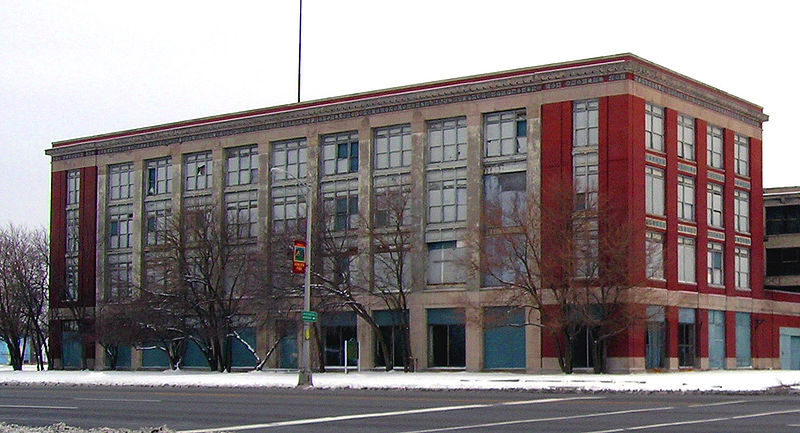 In
1915, James Couzens resigned from the Ford Motor Company,
recognizing that it Henry's company, and that no one else's
opinion would ever matter as much. In 1916, Ford antagonized the
other shareholders by declaring a paltry dividend, even in the
face of record profits. In response, the shareholders sued, and
in 1919 the Michigan Supreme Court upheld a lower court ruling
that it was unreasonable to withhold fair dividends under the
circumstances. The Ford Motor Company was forced to distribute
$19 million in dividend payments. In his own response to the
escalating feud, Henry threatened publicly to leave the company
and form a new one. He even made plans and discussed the next
car he would produce. In
1915, James Couzens resigned from the Ford Motor Company,
recognizing that it Henry's company, and that no one else's
opinion would ever matter as much. In 1916, Ford antagonized the
other shareholders by declaring a paltry dividend, even in the
face of record profits. In response, the shareholders sued, and
in 1919 the Michigan Supreme Court upheld a lower court ruling
that it was unreasonable to withhold fair dividends under the
circumstances. The Ford Motor Company was forced to distribute
$19 million in dividend payments. In his own response to the
escalating feud, Henry threatened publicly to leave the company
and form a new one. He even made plans and discussed the next
car he would produce.
Fearing that the worth of Ford stock would plummet, the minority
shareholders suddenly became eager to sell; agents working
surreptitiously for Henry Ford quietly bought up lot after lot
of shares. The sellers did not receive all that the shares were
worth, because of the rumors, but they each emerged with a
fortune. James Couzens, the most wily of the lot, received the
highest price per share, and turned to a career in the U.S.
Senate (he won his race, unlike the old boss) with $30 million
in the bank. Ford gained complete control of the company at a
cost of $125 million -- $106 million of the stock, plus $19
million for the court-ordered dividend -- a fantastic outlay
that he financed with a $75 million loan from two eastern banks.
On July 11, 1919, when he signed the last stock transfer
agreement, the fifty-five-year-old mogul was so enthused that he
danced a jig. The stock was divided up and placed in the names
of Henry, Clara, and Edsel Ford.
In 1921, the Model T Ford held 60 percent of the new-car market.
Plants around the world turned out flivvers as though they were
subway tokens, and Henry Ford's only problem, as he often stated
it, was figuring out how to make enough of them. As a concession
to diversification, he purchased the Lincoln Motor Car Company
in 1921. Company plans seemed to be in place for a long,
predictable future and Ford was free to embark on a great new
project: the design and construction of the world's largest and
most efficient automobile factory at River Rouge, near Detroit.
Arrayed over 2,000 acres, it would include 90 miles of railroad
track and enough space for 75,000 employees to produce finished
cars from raw material in the span of just forty-one hours.
River Rouge had its own power plant, iron forges, and
fabricating facilities. No detail was overlooked: wastepaper
would be recycled into cardboard at the factory's own paper
mill. River Rouge was built to produce Model T Fords for decades
to come, by the time it was capable of full production later in
the decade, a factory a tenth its size could have handled the
demand for Model Ts.
Ford Motor Company
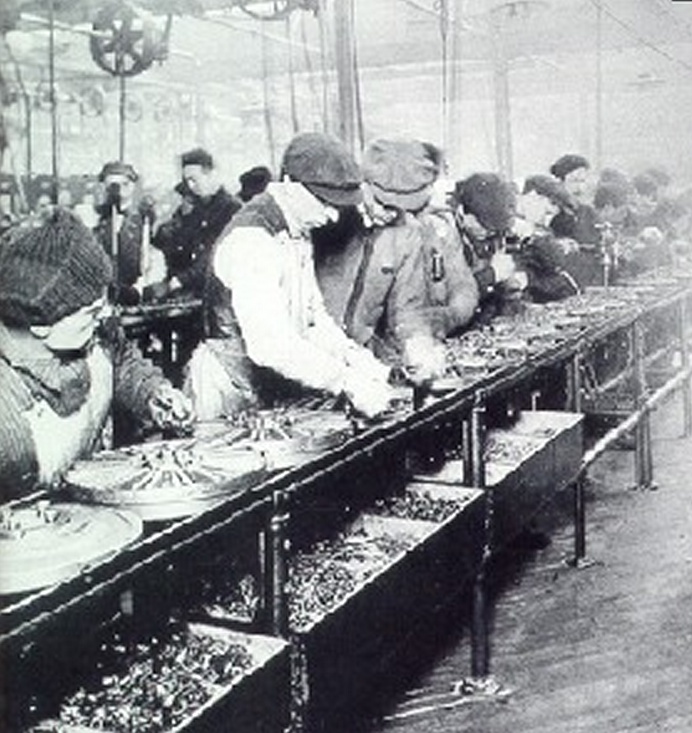 In response, Malcomson brought in another group of investors
and convinced the Dodge Brothers to accept a portion of the new
company. Ford & Malcomson was reincorporated as the
Ford Motor Company on June 16, 1903, with $28,000 capital.
The original investors included Ford and Malcomson, the Dodge
brothers, Malcomson's uncle
John S. Gray,
James Couzens, and two of Malcomson's lawyers, John W.
Anderson and
Horace Rackham. In a newly designed car, Ford gave an
exhibition on the ice of
Lake St. Clair, driving 1 mile (1.6 km) in 39.4 seconds,
setting a new
land speed record at 91.3 miles per hour (147.0 km/h).
Convinced by this success, the race driver
Barney Oldfield, who named this new Ford model "999" in
honor of a racing locomotive of the day, took the car around the
country, making the Ford brand known throughout the United
States. Ford also was one of the early backers of the
Indianapolis 500. In response, Malcomson brought in another group of investors
and convinced the Dodge Brothers to accept a portion of the new
company. Ford & Malcomson was reincorporated as the
Ford Motor Company on June 16, 1903, with $28,000 capital.
The original investors included Ford and Malcomson, the Dodge
brothers, Malcomson's uncle
John S. Gray,
James Couzens, and two of Malcomson's lawyers, John W.
Anderson and
Horace Rackham. In a newly designed car, Ford gave an
exhibition on the ice of
Lake St. Clair, driving 1 mile (1.6 km) in 39.4 seconds,
setting a new
land speed record at 91.3 miles per hour (147.0 km/h).
Convinced by this success, the race driver
Barney Oldfield, who named this new Ford model "999" in
honor of a racing locomotive of the day, took the car around the
country, making the Ford brand known throughout the United
States. Ford also was one of the early backers of the
Indianapolis 500.
Model T
The
Model T was introduced on October 1, 1908. It had the
steering wheel on the left, which every other company soon
copied. The entire engine and transmission were enclosed; the
four cylinders were cast in a solid block; the suspension used
two semi-elliptic springs. The car was very simple to drive, and
easy and cheap to repair. It was so cheap at $825 in 1908
($21,340 today) (the price fell every year) that by the 1920s, a
majority of American drivers had learned to drive on the Model
T.
Ford created a massive publicity machine in Detroit to ensure
every newspaper carried stories and ads about the new product.
Ford's network of local dealers made the car ubiquitous in
virtually every city in North America. As independent dealers,
the franchises grew rich and publicized not just the Ford but
the very concept of automobiling; local motor clubs sprang up to
help new drivers and to encourage exploring the countryside.
Ford was always eager to sell to farmers, who looked on the
vehicle as a commercial device to help their business. Sales
skyrocketed?several years posted 100% gains on the previous
year. Always on the hunt for more efficiency and lower costs, in
1913 Ford introduced the moving assembly belts into his plants,
which enabled an enormous increase in production. Although Ford
is often credited with the idea, contemporary sources indicate
that the concept and its development came from employees
Clarence Avery,
Peter E. Martin,
Charles E. Sorensen, and
C. Harold Wills.
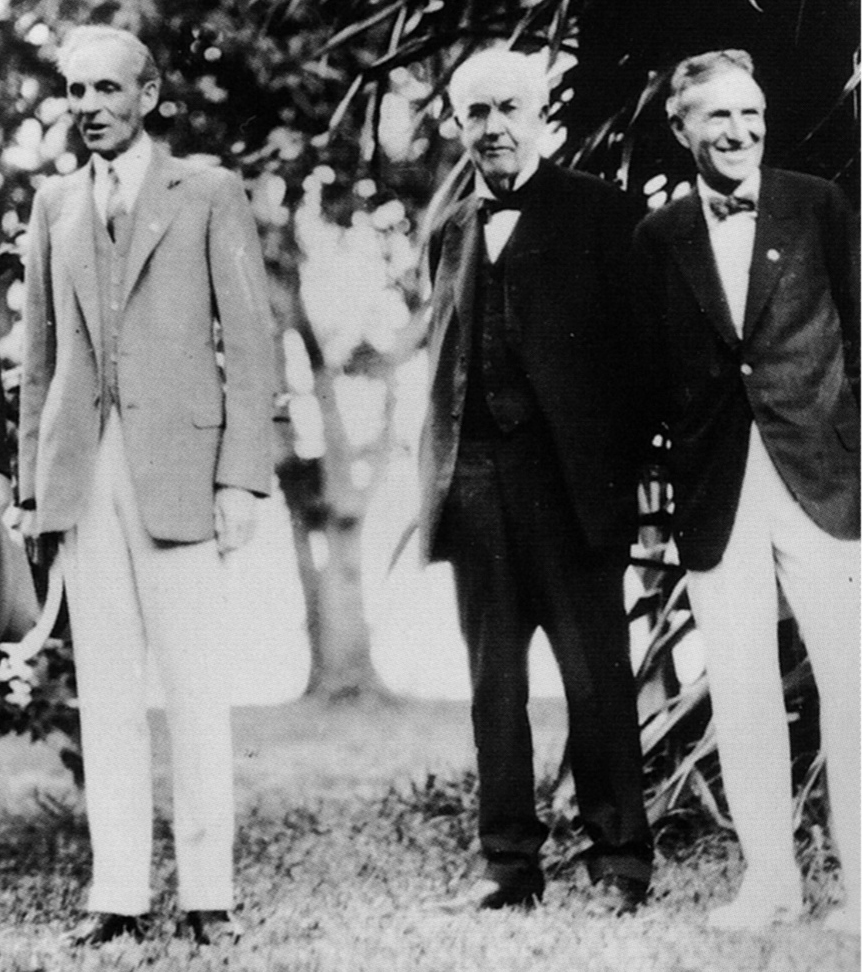 Sales passed 250,000 in 1914. By 1916, as the price dropped
to $360 for the basic touring car, sales reached 472,000. (Using
the consumer price index, this price was equivalent to $7,020 in
2008 dollars.) Sales passed 250,000 in 1914. By 1916, as the price dropped
to $360 for the basic touring car, sales reached 472,000. (Using
the consumer price index, this price was equivalent to $7,020 in
2008 dollars.)
By 1918, half of all cars in America were Model T's. However,
it was a monolithic black; as Ford wrote in his autobiography,
"Any customer can have a car painted any color that he wants so
long as it is black". Until the development of the assembly
line, which mandated black because of its quicker drying time,
Model T's were available in other colors, including red. The
design was fervently promoted and defended by Ford, and
production continued as late as 1927; the final total production
was 15,007,034. This record stood for the next 45 years. This
record was achieved in just 19 years from the introduction of
the first
Model T (1908).
President
Woodrow Wilson asked Ford to run as a Democrat for the
United States Senate from Michigan in 1918. Although the
nation was at war, Ford ran as a peace candidate and a strong
supporter of the proposed
League of Nations.
 Henry Ford turned the presidency of Ford Motor Company over
to his son
Edsel Ford in December 1918. Henry, however, retained final
decision authority and sometimes reversed his son. Henry started
another company, Henry Ford and Son, and made a show of taking
himself and his best employees to the new company; the goal was
to scare the remaining holdout stockholders of the Ford Motor
Company to sell their stakes to him before they lost most of
their value. (He was determined to have full control over
strategic decisions.) The ruse worked, and Henry and Edsel
purchased all remaining stock from the other investors, thus
giving the family sole ownership of the company. Henry Ford turned the presidency of Ford Motor Company over
to his son
Edsel Ford in December 1918. Henry, however, retained final
decision authority and sometimes reversed his son. Henry started
another company, Henry Ford and Son, and made a show of taking
himself and his best employees to the new company; the goal was
to scare the remaining holdout stockholders of the Ford Motor
Company to sell their stakes to him before they lost most of
their value. (He was determined to have full control over
strategic decisions.) The ruse worked, and Henry and Edsel
purchased all remaining stock from the other investors, thus
giving the family sole ownership of the company.
By the mid-1920s, sales of the Model T began to decline due
to rising competition. Other auto makers offered payment plans
through which consumers could buy their cars, which usually
included more modern mechanical features and styling not
available with the Model T. Despite urgings from Edsel, Henry
steadfastly refused to incorporate new features into the Model T
or to form a customer credit plan.
Model A and Ford's later career
By 1926, flagging sales of the Model T finally convinced
Henry to make a new model. He pursued the project with a great
deal of technical expertise in design of the engine, chassis,
and other mechanical necessities, while leaving the body design
to his son. Edsel also managed to prevail over his father's
initial objections in the inclusion of a sliding-shift
transmission.
The result was the successful
Ford Model A, introduced in December 1927 and produced
through 1931, with a total output of more than 4 million.
Subsequently, the Ford company adopted an annual model change
system similar to that recently pioneered by its competitor
General Motors (and still in use by automakers today). Not until
the 1930s did Ford overcome his objection to finance companies,
and the Ford-owned
Universal Credit Corporation became a major car-financing
operation.
Ford did not believe in accountants; he amassed one of the
world's largest fortunes without ever having his company
audited under his administration.
Labor philosophy
The
five-dollar workday
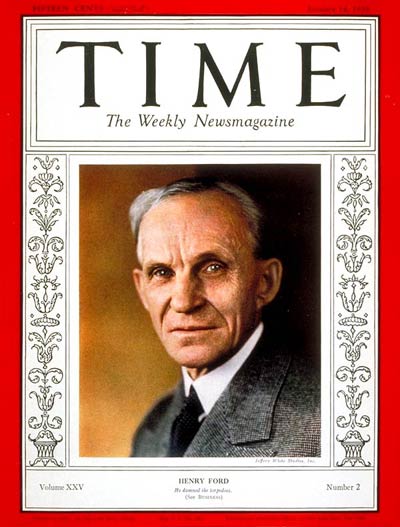 Ford was a pioneer of "welfare
capitalism", designed to improve the lot of his workers and
especially to reduce the heavy
turnover that had many departments hiring 300 men per year
to fill 100 slots. Efficiency meant hiring and keeping the best
workers. Ford was a pioneer of "welfare
capitalism", designed to improve the lot of his workers and
especially to reduce the heavy
turnover that had many departments hiring 300 men per year
to fill 100 slots. Efficiency meant hiring and keeping the best
workers.
Ford astonished the world in 1914 by offering a $5 per day
wage ($120 today), which more than doubled the rate of most of
his workers. A Cleveland, Ohio newspaper editorialized that the
announcement "shot like a blinding rocket through the dark
clouds of the present industrial depression." The move proved
extremely profitable; instead of constant turnover of employees,
the best mechanics in Detroit flocked to Ford, bringing their
human capital and expertise, raising productivity, and lowering
training costs. Ford announced his $5-per-day program on January
5, 1914, raising the minimum daily pay from $2.34 to $5 for
qualifying workers. It also set a new, reduced workweek,
although the details vary in different accounts. Ford and
Crowther in 1922 described it as six 8-hour days, giving a
48-hour week, while in 1926 they described it as five 8-hour
days, giving a 40-hour week. (Apparently the program started
with Saturdays as workdays and sometime later it was changed to
a day off.)
Detroit was already a high-wage city, but competitors were
forced to raise wages or lose their best workers. Ford's policy
proved, however, that paying people more would enable Ford
workers to afford the cars they were producing and be good for
the economy. Ford explained the policy as profit-sharing rather
than wages. It may have been
Couzens who convinced Ford to adopt the $5 day.
The profit-sharing was offered to employees who had worked at
the company for six months or more, and, importantly, conducted
their lives in a manner of which Ford's "Social Department"
approved. They frowned on heavy drinking, gambling, and what
might today be called "deadbeat
dads". The Social Department used 50 investigators, plus
support staff, to maintain employee standards; a large
percentage of workers were able to qualify for this
"profit-sharing."
Ford's incursion into his employees' private lives was highly
controversial, and he soon backed off from the most intrusive
aspects. By the time he wrote his 1922 memoir, he spoke of the
Social Department and of the private conditions for
profit-sharing in the past tense, and admitted that "paternalism
has no place in industry. Welfare work that consists in prying
into employees' private concerns is out of date. Men need
counsel and men need help, oftentimes special help; and all this
ought to be rendered for decency's sake. But the broad workable
plan of investment and participation will do more to solidify
industry and strengthen organization than will any social work
on the outside. Without changing the principle we have changed
the method of payment."
Labor unions
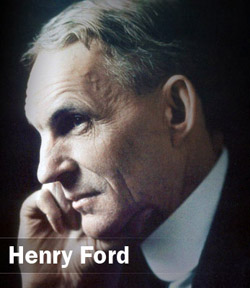 Ford was adamantly against
labor unions. He explained his views on unions in Chapter 18
of My Life and Work. He thought they were too heavily
influenced by some leaders who, despite their ostensible good
motives, would end up doing more harm than good for workers.
Most wanted
to restrict productivity as a means to foster employment, but
Ford saw this as self-defeating because, in his view,
productivity was necessary for any economic prosperity to exist. Ford was adamantly against
labor unions. He explained his views on unions in Chapter 18
of My Life and Work. He thought they were too heavily
influenced by some leaders who, despite their ostensible good
motives, would end up doing more harm than good for workers.
Most wanted
to restrict productivity as a means to foster employment, but
Ford saw this as self-defeating because, in his view,
productivity was necessary for any economic prosperity to exist.
He believed that productivity gains that obviated certain
jobs would nevertheless stimulate the larger economy and thus
grow new jobs elsewhere, whether within the same corporation or
in others. Ford also believed that union leaders (particularly
Leninist-leaning ones) had a perverse incentive to foment
perpetual socio-economic crisis as a way to maintain their own
power. Meanwhile, he believed that smart managers had an
incentive to do right by their workers, because doing so would
maximize their own profits. (Ford did acknowledge, however, that
many managers were basically too bad at managing to understand
this fact.) But Ford believed that eventually, if good managers
such as he could fend off the attacks of misguided people from
both left and right (i.e., both socialists and bad-manager
reactionaries), the good managers would create a socio-economic
system wherein neither bad management nor bad unions could find
enough support to continue existing.
To forestall union activity, Ford promoted
Harry Bennett, a former
Navy boxer, to head the Service Department. Bennett employed
various intimidation tactics to squash union organizing. The
most famous incident, in 1937, was a bloody brawl between
company security men and organizers that became known as
The Battle of the Overpass.
In the late 1930s and early 1940s, Edsel (who was president
of the company) thought Ford had to come to some sort of
collective bargaining agreement with the unions, because the
violence, work disruptions, and bitter stalemates could not go
on forever. But Henry (who still had the final veto in the
company on a de facto basis even if not an official one)
refused to cooperate. For several years, he kept Bennett in
charge of talking to the unions that were trying to organize the
Ford company. Sorensen's memoir makes clear that Henry's purpose
in putting Bennett in charge was to make sure no agreements were
ever reached.
The Ford company was the last Detroit automaker to recognize
the
United Auto Workers union (UAW). A sit-down strike by the
UAW union in April 1941 closed the
River Rouge Plant. Sorensen recounted that a distraught
Henry Ford was very close to following through with a threat to
break up the company rather than cooperate but that his wife
Clara told him she would leave him if he destroyed the family
business. She wanted to see their son and grandsons lead it into
the future. Henry complied with his wife's ultimatum. Overnight,
the Ford Motor Co. went from the most stubborn holdout among
automakers to the one with the most favorable UAW contract
terms. The contract was signed in June 1941.
Ford Airplane Company
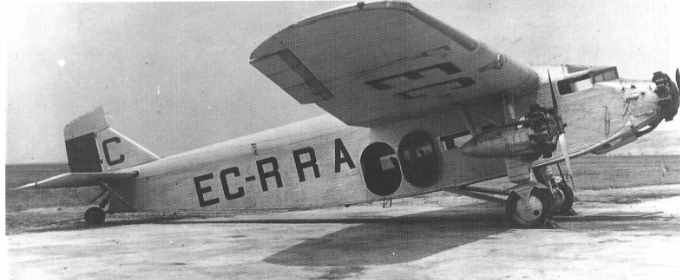 Ford, like other automobile companies, entered the aviation
business during
World War I, building Liberty engines. After the war, it
returned to auto manufacturing until 1925, when Ford acquired
the
Stout Metal Airplane Company. Ford, like other automobile companies, entered the aviation
business during
World War I, building Liberty engines. After the war, it
returned to auto manufacturing until 1925, when Ford acquired
the
Stout Metal Airplane Company.
Ford's most successful aircraft was the
Ford 4AT Trimotor, often called the "Tin Goose" because of
its corrugated metal construction. It used a new alloy called
Alclad that combined the corrosion resistance of aluminum
with the strength of
duralumin. The plane was similar to
Fokker's V.VII-3m, and some say that Ford's engineers
surreptitiously measured the Fokker plane and then copied it.
The Trimotor first flew on June 11, 1926, and was the first
successful U.S. passenger airliner, accommodating about 12
passengers in a rather uncomfortable fashion. Several variants
were also used by the
U.S. Army. Ford has been honored by the
Smithsonian Institution for changing the aviation industry.
199 Trimotors were built before it was discontinued in 1933,
when the Ford Airplane Division shut down because of poor sales
during the
Great Depression.
Willow Run
President
Franklin D. Roosevelt referred to Detroit as the "Arsenal
of Democracy". The Ford Motor Company played a pivotal role
in the
Allied victory during World War I and
World War II. With Europe under siege, the Ford company's
genius turned to mass production for the war effort.
Specifically, Ford developed mass production for the
B-24 Liberator bomber, still the most-produced
Allied bomber in history. When the planes started being used
in the war zones, the balance of power shifted to the Allies.
Before Ford, and under optimal conditions, the aviation
industry could produce one Consolidated Aircraft B-24 Bomber a
day at an aircraft plant. Ford showed the world how to produce
one B-24 an hour at a peak of 600 per month in 24-hour shifts.
Ford's
Willow Run factory broke ground in April 1941. At the time,
it was the largest assembly plant in the world, with over
3,500,000 square feet (330,000 m).
Mass production of the B-24, led by Charles Sorensen and
later Mead Bricker, began by August 1943. Many pilots slept on
cots waiting for takeoff as the B-24s rolled off the assembly
line at Ford's Willow Run facility.
Peace and war
 World War I
era World War I
era
Ford opposed war, which he thought was a terrible waste. Ford
became highly critical of those who he felt financed war, and he
tried to stop them. In 1915, the pacifist
Rosika Schwimmer gained favor with Ford, who agreed to fund
a peace ship to Europe, where World War I was raging. He and
about 170 other prominent peace leaders traveled there. Ford's
Episcopalian pastor, Reverend Samuel S. Marquis, accompanied him
on the mission. Marquis headed Ford's Sociology Department from
1913 to 1921. Ford talked to President Wilson about the mission
but had no government support. His group went to neutral Sweden
and the Netherlands to meet with peace activists. A target of
much ridicule, Ford left the ship as soon as it reached Sweden.
Ford plants in Britain produced tractors to increase the
British food supply, as well as trucks and aircraft engines.
When the U.S. entered the war in 1917 the company became a major
supplier of weapons, especially the Liberty engine for
airplanes, and anti-submarine boats.
In 1918, with the war on and the
League of Nations a growing issue in global politics,
President
Woodrow Wilson, a Democrat, encouraged Ford to run for a
Michigan seat in the U.S. Senate. Wilson believed that Ford
could tip the scales in Congress in favor of Wilson's proposed
League. "You are the only man in Michigan who can be elected
and help bring about the peace you so desire," the president
wrote Ford. Ford wrote back: "If they want to elect me let them
do so, but I won't make a penny's investment." Ford did run,
however, and came within 4,500 votes of winning, out of more
than 400,000 cast statewide.
Mental collapse and World War II
Ford had long opposed war and continued to believe that
international business could generate the prosperity that would
head off wars; when World War II erupted in 1939 he said the
people of the world had been duped. Like many other businessmen
of the Great Depression era, he never liked or entirely trusted
the Franklin Roosevelt Administration. He was not, however,
active in
the isolationist movement of 1939?41, and he supported the
American war effort and realized the need to support Britain
with weapons to fight the Nazis. However, when
Rolls-Royce sought a US manufacturer as an alternative
source for the
Merlin engine (as fitted to the
Spitfire and
Hurricane), Ford first agreed to do so and then
reneged. He "lined up behind the war effort" when the U.S.
entered in late 1941, and the company became a major component
of the "Arsenal
of Democracy." Following a series of strokes in the late
1930s he became increasingly senile and was more of a
figurehead; other people made the decisions in his name. After
Edsel Ford's death, Henry Ford nominally resumed control of
the company in 1943, but his mental strength was fading fast. In
reality the company was controlled by a handful of senior
executives led by
Charles Sorensen and
Harry Bennett; Sorensen was forced out in 1944. Ford's
incompetence led to discussions in Washington about how to
restore the company, whether by wartime government fiat or by
instigating some sort of coup among executives and directors.
Nothing happened until 1945, with bankruptcy a serious risk,
Edsel's widow led an ouster and installed her son,
Henry Ford II, as president; the young man fired Bennett and
took full control.
The Dearborn Independent -
Antisemitism
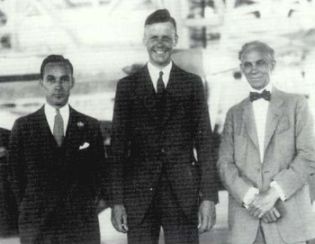 Ford in the early 1920s sponsored a weekly newspaper that
published (among many non-controversial articles) strongly anti-semitic
views. At the same time Ford had a reputation as one of the few
major corporations actively hiring black workers; he was not
accused of discrimination against Jewish workers or suppliers. Ford in the early 1920s sponsored a weekly newspaper that
published (among many non-controversial articles) strongly anti-semitic
views. At the same time Ford had a reputation as one of the few
major corporations actively hiring black workers; he was not
accused of discrimination against Jewish workers or suppliers.
In 1918, Ford's closest aide and private secretary,
Ernest G. Liebold, purchased an obscure weekly newspaper for
Ford,
The Dearborn Independent. The Independent ran for
eight years, from 1920 until 1927, during which Liebold was
editor. Every Ford franchise nation-wide had to carry the paper
and distribute it to its customers.
The newspaper published
The Protocols of the Elders of Zion, which was
discredited by
The Times of London as a forgery during the
Independent's publishing run. The
American Jewish Historical Society described the ideas
presented in the magazine as "anti-immigrant,
anti-labor, anti-liquor, and
anti-Semitic." In February 1921, the
New York World published an interview with Ford, in
which he said: "The only statement I care to make about the
Protocols is that they fit in with what is going on." During
this period, Ford emerged as "a respected spokesman for
right-wing extremism and religious prejudice," reaching around
700,000 readers through his newspaper. The 2010 documentary film
Jews and Baseball: An American Love Story (written by
Pulitzer Prize winner
Ira Berkow) noted that Ford wrote on May 22, 1920: ?If fans
wish to know the trouble with American baseball they have it in
three words?too much Jew.?
In Germany, Ford's anti-Jewish articles from The Dearborn
Independent were issued in four volumes, cumulatively titled
The International Jew, the World's Foremost Problem
published by
Theodor Fritsch, founder of several anti-semitic parties and
a member of the Reichstag. In a letter from 1924,
Heinrich Himmler described Ford as "one of our most
valuable, important, and witty fighters." Ford is the only
American mentioned in
Mein Kampf. Speaking in 1931 to a Detroit News reporter,
Hitler said he regarded Ford as his "inspiration", explaining
his reason for keeping Ford's life-size portrait next to his
desk.
Steven Watts wrote that Hitler "revered" Ford, proclaiming
that "I shall do my best to put his theories into practice in
Germany," and modeling the
Volkswagen, the people's car, on the model T.
 On February 1, 1924, Ford received
Kurt Ludecke, a representative of Hitler, at his home.
Ludecke was introduced to Ford by
Siegfried Wagner (son of the famous composer
Richard Wagner) and his wife
Winifred, both Nazi sympathizers and anti-Semites. Ludecke
asked Ford for a contribution to the Nazi cause, but was
apparently refused. On February 1, 1924, Ford received
Kurt Ludecke, a representative of Hitler, at his home.
Ludecke was introduced to Ford by
Siegfried Wagner (son of the famous composer
Richard Wagner) and his wife
Winifred, both Nazi sympathizers and anti-Semites. Ludecke
asked Ford for a contribution to the Nazi cause, but was
apparently refused.
While Ford's articles were denounced by the
Anti-Defamation League (ADL), the articles explicitly
condemned
pogroms and violence against Jews (Volume 4, Chapter 80),
but blamed the Jews for provoking incidents of mass violence.
None of this work was written by Ford, but he allowed his name
to be used as author. According to trial testimony, he wrote
almost nothing. Friends and business associates have said they
warned Ford about the contents of the Independent and
that he probably never read the articles. (He claimed he only
read the headlines.) But, court testimony in a
libel suit, brought by one of the targets of the newspaper,
alleged that Ford did know about the contents of the
Independent in advance of publication.
A libel lawsuit brought by San Francisco lawyer and Jewish
farm cooperative organizer
Aaron Sapiro in response to anti-Semitic remarks led Ford to
close the Independent in December 1927. News reports at
the time quoted him as saying he was shocked by the content and
unaware of its nature. During the trial, the editor of Ford's
"Own Page," William Cameron, testified that Ford had nothing to
do with the editorials even though they were under his byline.
Cameron testified at the libel trial that he never discussed the
content of the pages or sent them to Ford for his approval.
Investigative journalist
Max Wallace noted that "whatever credibility this absurd
claim may have had was soon undermined when James M. Miller, a
former Dearborn Independent employee, swore under oath
that Ford had told him he intended to expose Sapiro."
Michael Barkun observed,
That Cameron would have continued to publish such
controversial material without Ford's explicit instructions
seemed unthinkable to those who knew both men. Mrs. Stanley
Ruddiman, a Ford family intimate, remarked that 'I don't
think Mr. Cameron ever wrote anything for publication
without Mr. Ford's approval.'
According to Spencer Blakeslee,
The ADL mobilized prominent Jews and non-Jews to publicly
oppose Ford's message. They formed a coalition of Jewish
groups for the same purpose and raised constant objections
in the Detroit press. Before leaving his presidency early in
1921, Woodrow Wilson joined other leading Americans in a
statement that rebuked Ford and others for their antisemitic
campaign. A boycott against Ford products by Jews and
liberal Christians also had an impact, and Ford shut down
the paper in 1927, recanting his views in a public letter to
Sigmund Livingston, ADL.
Ford's 1927 apology was well received. "Four-Fifths of the
hundreds of letters addressed to Ford in July 1927 were from
Jews, and almost without exception they praised the
Industrialist." In January 1937, a Ford statement to the
Detroit Jewish Chronicle disavowed "any connection
whatsoever with the publication in Germany of a book known as
the International Jew."
In July 1938, prior to the outbreak of war, the German consul
at
Cleveland gave Ford, on his 75th birthday, the award of the
Grand Cross of the German Eagle, the highest medal Nazi
Germany could bestow on a foreigner. James D. Mooney,
vice-president of overseas operations for
General Motors, received a similar medal, the Merit Cross of
the German Eagle, First Class.
Distribution of International Jew was halted in 1942
through legal action by Ford, despite complications from a lack
of copyright. It is still banned in Germany. Extremist groups
often recycle the material; it still appears on
antisemitic and
neo-Nazi websites.
One Jewish public figure who was said to have been friendly
with Ford was Detroit Judge
Harry Keidan. When asked about this connection, Ford replied
that Keidan was only half-Jewish. A close collaborator of Ford
during World War II reported that Ford, at the time over 80
years old, was shown a movie of the
Nazi concentration camps and was ill stricken by the
atrocities.
The damage, however, had been done. Testifying at
Nuremberg, convicted
Hitler Youth leader
Baldur von Schirach who, in his role as military governor of
Vienna deported 65,000 Jews to camps in Poland, stated,
The decisive anti-Semitic book I was reading and the book
that influenced my comrades was [...] that book by Henry
Ford, "The International Jew." I read it and became
anti-Semitic. The book made a great influence on myself and
my friends because we saw in Henry Ford the representative
of success and also the representative of a progressive
social policy.
International business
Ford's philosophy was one of economic independence for the
United States. His River Rouge Plant became the world's largest
industrial complex, pursuing
vertical integration to such an extent that it could produce
its own steel. Ford's goal was to produce a vehicle from scratch
without reliance on foreign trade. He believed in the global
expansion of his company. He believed that international trade
and cooperation led to international peace, and he used the
assembly line process and production of the Model T to
demonstrate it.
He opened Ford assembly plants in Britain and Canada in 1911,
and soon became the biggest automotive producer in those
countries. In 1912, Ford cooperated with
Giovanni Agnelli of
Fiat
to launch the first Italian automotive assembly plants. The
first plants in Germany were built in the 1920s with the
encouragement of
Herbert Hoover and the Commerce Department, which agreed
with Ford's theory that international trade was essential to
world peace. In the 1920s, Ford also opened plants in Australia,
India, and France, and by 1929, he had successful dealerships on
six continents. Ford experimented with a commercial rubber
plantation in the
Amazon jungle called
Fordl?ndia; it was one of his few failures. In 1929, Ford
accepted
Joseph Stalin's invitation to build a model plant (NNAZ,
today GAZ)
at Gorky, a city now known under its historical name
Nizhny Novgorod. He sent American engineers and technicians
to the Soviet Union to help set it up, including future labor
leader
Walter Reuther.
The Ford Motor Company had the policy of doing business in
any nation where the United States had diplomatic relations. It
set up numerous subsidiaries that sold cars and trucks and
sometimes assembled them:
- Ford of Australia
-
Ford of Britain
- Ford of Argentina
- Ford of Brazil
- Ford of Canada
- Ford of Europe
- Ford India
- Ford South Africa
- Ford Mexico
- Ford Philippines
By 1932, Ford was manufacturing one third of all the world?s
automobiles. Ford's image transfixed Europeans, especially the
Germans, arousing the "fear of some, the infatuation of others,
and the fascination among all". Germans who discussed "Fordism"
often believed that it represented something quintessentially
American. They saw the size, tempo, standardization, and
philosophy of production demonstrated at the Ford Works as a
national service?an "American thing" that represented the
culture of United States. Both supporters and critics
insisted that Fordism epitomized American capitalist
development, and that the auto industry was the key to
understanding economic and social relations in the United
States. As one German explained, "Automobiles have so completely
changed the American's mode of life that today one can hardly
imagine being without a car. It is difficult to remember what
life was like before Mr. Ford began preaching his doctrine of
salvation". For many Germans, Ford embodied the essence of
successful Americanism.
In My Life and Work, Ford predicted that if greed,
racism, and short-sightedness could be overcome, then economic
and technological development throughout the world would
progress to the point that international trade would no longer
be based on (what today would be called) colonial or
neocolonial models and would truly benefit all peoples. His
ideas in this passage were vague, but they were idealistic.
Racing
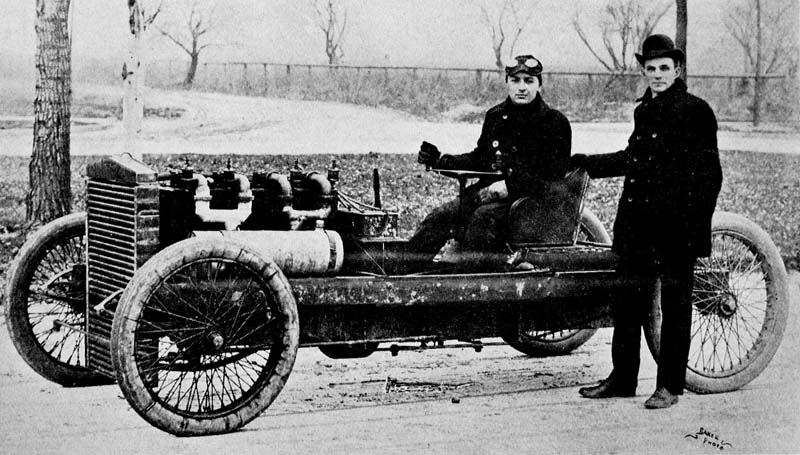 Ford maintained an interest in auto racing from 1901 to 1913
and began his involvement in the sport as both a builder and a
driver, later turning the wheel over to hired drivers. He
entered stripped-down
Model Ts in races, finishing first (although later
disqualified) in an "ocean-to-ocean" (across the United States)
race in 1909, and setting a one-mile (1.6 km) oval speed record
at Detroit Fairgrounds in 1911 with driver Frank Kulick. In
1913, Ford attempted to enter a reworked Model T in the
Indianapolis 500 but was told rules required the addition of
another 1,000 pounds (450 kg) to the car before it could
qualify. Ford dropped out of the race and soon thereafter
dropped out of racing permanently, citing dissatisfaction with
the sport's rules, demands on his time by the booming production
of the Model Ts, and his low opinion of racing as a worthwhile
activity. Ford maintained an interest in auto racing from 1901 to 1913
and began his involvement in the sport as both a builder and a
driver, later turning the wheel over to hired drivers. He
entered stripped-down
Model Ts in races, finishing first (although later
disqualified) in an "ocean-to-ocean" (across the United States)
race in 1909, and setting a one-mile (1.6 km) oval speed record
at Detroit Fairgrounds in 1911 with driver Frank Kulick. In
1913, Ford attempted to enter a reworked Model T in the
Indianapolis 500 but was told rules required the addition of
another 1,000 pounds (450 kg) to the car before it could
qualify. Ford dropped out of the race and soon thereafter
dropped out of racing permanently, citing dissatisfaction with
the sport's rules, demands on his time by the booming production
of the Model Ts, and his low opinion of racing as a worthwhile
activity.
Berna Eli "Barney" Oldfield (June 3, 1878
? October 4, 1946) was an American automobile racer and pioneer.
He was the first man to drive a car at 60 miles per hour (96
km/h) on an oval.[1] His accomplishments led to the expression
"Who do you think you are? Barney Oldfield?". Oldfield was lent
a gasoline-powered bicycle to race at Salt Lake City, which led
to a meeting with Henry Ford. Ford had readied two automobiles
for racing, and he asked Oldfield if he would like to test one
at Ford's Grosse Pointe track. Oldfield agreed and traveled to
Michigan for the trial, but neither car would start. In spite of
the fact that Oldfield had still never driven an automobile, he
and fellow racing cyclist Tom Cooper purchased both test
vehicles when Ford offered to sell them for $800. One of those
first vehicles was the famous "No. 999" which debuted in
October, 1902 at the Manufacturer's Challenge Cup. The car can
be found today at the Henry Ford Museum in Greenfield Village.
In My Life and Work Ford speaks (briefly) of racing in
a rather dismissive tone, as something that is not at all a good
measure of automobiles in general. He describes himself as
someone who raced only because in the 1890s through 1910s, one
had to race because prevailing ignorance held that racing was
the way to prove the worth of an automobile. Ford did not agree.
But he was determined that as long as this was the definition of
success (flawed though the definition was), then his cars would
be the best that there were at racing. Throughout the book, he
continually returns to ideals such as transportation, production
efficiency, affordability, reliability, fuel efficiency,
economic prosperity, and the automation of drudgery in farming
and industry, but rarely mentions, and rather belittles, the
idea of merely going fast from point A to point B.
Nevertheless, Ford did make quite an impact on auto racing
during his racing years, and he was inducted into the
Motorsports Hall of Fame of America in 1996.
Later
career
When Edsel, president of Ford Motor Company, died of cancer
in May 1943, the elderly and ailing Henry Ford decided to assume
the presidency. By this point in his life, he had had several
cardiovascular events (variously cited as heart attack or
stroke) and was mentally inconsistent, suspicious, and generally
no longer fit for such a job.
Most of the directors did not want to see him as president.
But for the previous 20 years, though he had long been without
any official executive title, he had always had de facto
control over the company; the board and the management had never
seriously defied him, and this moment was not different. The
directors elected him, and he served until the end of the war.
During this period the company began to decline, losing more
than $10 million a month ($134,310,000 a month today). The
administration of President
Franklin Roosevelt had been considering a government
takeover of the company in order to ensure continued war
production, but the idea never progressed.
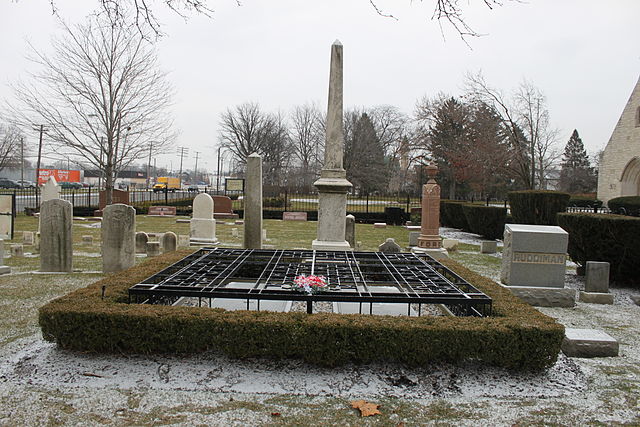
Death
In ill health, Ford ceded the presidency to his grandson
Henry Ford II in September 1945 and went into retirement. He
died in 1947 of a
cerebral hemorrhage at age 83 in
Fair Lane, his Dearborn estate. A public viewing was held at
Greenfield Village where up to 5,000 people per hour filed past
the casket. Funeral services were held in Detroit's
Cathedral Church of St. Paul and he was buried in the Ford
Cemetery in Detroit.
Interesting Facts
Interest in materials science and engineering
Henry Ford long had an interest in
materials science and engineering. He enthusiastically
described his company's adoption of vanadium steel alloys and
subsequent metallurgic R&D work.
Ford long had an interest in plastics developed from
agricultural products, especially
soybeans. He cultivated a relationship with
George Washington Carver for this purpose. Soybean-based
plastics were used in Ford automobiles throughout the 1930s in
plastic parts such as car horns, in paint, etc. This project
culminated in 1942, when Ford
patented an automobile made almost entirely of plastic,
attached to a tubular welded frame. It weighed 30% less than a
steel car and was said to be able to withstand blows ten times
greater than could steel. Furthermore, it ran on grain alcohol (ethanol)
instead of gasoline. The design never caught on.
Ford was interested in
engineered woods ("Better wood can be made than is grown")
(at this time plywood and particle board were little more than
experimental ideas);
corn as a fuel source, via both corn oil and ethanol; and
the potential uses of cotton. Ford was instrumental in
developing charcoal
briquets, under the brand name "Kingsford".
His brother in law,
E.G. Kingsford, used wood scraps from the Ford factory to
make the briquets.
Ford was a
prolific inventor and was awarded 161 U.S. patents.
Georgia residence and community
Ford maintained a vacation residence (known as the "Ford
Plantation") in
Richmond Hill, Georgia. He contributed substantially to the
community, building a chapel and schoolhouse and employing
numerous local residents.
Preserving
Americana
Ford had an interest in "Americana".
In the 1920s, Ford began work to turn
Sudbury, Massachusetts, into a themed historical village. He
moved the schoolhouse supposedly referred to in the nursery
rhyme, "Mary
had a little lamb", from
Sterling, Massachusetts, and purchased the historic
Wayside Inn. This plan never saw fruition. Ford repeated the
concept of collecting historic structures with the creation of
Greenfield Village in
Dearborn, Michigan. It may have inspired the creation of
Old Sturbridge Village as well. About the same time, he
began collecting materials for his museum, which had a theme of
practical technology. It was opened in 1929 as the Edison
Institute. Although greatly modernized, the museum continues
today.
On the idea that he invented the automobile
Henry Ford did not invent the automobile, as is occasionally
believed. Indeed, he began as a race driver of other people's
cars. As Ford himself noted, by the 1870s, the notion of a
"horseless carriage was a common idea". Many people worked
toward the idea, as the history
of steam road vehicles and
of automobiles shows. Ford was, however, more influential
than any other single person in changing the paradigm of the
automobile from a very expensive, heavy, hand-built toy for rich
people into a lightweight, reliable, affordable, mass-produced
mode of transportation for working-class people.
On the idea that he invented the assembly line
Both Ford and
Ransom E. Olds are sometimes credited with the invention of
the
assembly line, although (as is the case with many
inventions) the assembly line's development included many
inventors. It combined the idea of
interchangeable parts (another gradual technological
development that is often mistakenly attributed to one
individual or another). After 5 years of empirical development,
Ford's first moving assembly line (employing conveyor belts)
began mass production on or around April 1, 1913. The concept
was first applied to subassemblies, and shortly after to the
entire chassis. Although it is inaccurate to say that Ford
personally invented the assembly line, his sponsorship of its
development and use was central to its explosive success in the
20th century.
Miscellaneous
Ford was the winner of the award of
Car Entrepreneur of the Century in 1999.
Ford published a book, circulated to youth in 1914, called
"The Case Against the Little White Slaver" which documented many
dangers of cigarette smoking attested to by many researchers and
luminaries.
Ford dressed up as
Santa Claus and gave sleigh rides to children at Christmas
time on his estate.
A compendium of short biographies of famous
Freemasons, published by a Freemason lodge, lists Ford as a
member.
Ford was especially fond of
Thomas Edison, and on Edison's deathbed, he demanded
Edison's son catch his final breath in a test tube. The test
tube can still be found today in
Henry Ford Museum.
In 1923, Ford's pastor, and head of his sociology department,
Episcopal minister Samuel S. Marquis, claimed that Ford
believed, or "once believed" in
reincarnation. Though it is unclear whether or how long Ford
kept such a belief, the
San Francisco Examiner from August 26, 1928, published a
quote which described Ford's beliefs:
I adopted the theory of Reincarnation when I was twenty
six. Religion offered nothing to the point. Even work could
not give me complete satisfaction. Work is futile if we
cannot utilise the experience we collect in one life in the
next. When I discovered Reincarnation it was as if I had
found a universal plan I realised that there was a chance to
work out my ideas. Time was no longer limited. I was no
longer a slave to the hands of the clock. Genius is
experience. Some seem to think that it is a gift or talent,
but it is the fruit of long experience in many lives. Some
are older souls than others, and so they know more. The
discovery of Reincarnation put my mind at ease. If you
preserve a record of this conversation, write it so that it
puts men?s minds at ease. I would like to communicate to
others the calmness that the long view of life gives to us.
Related Article:
Henry Ford - This is Your Life |

